What's inside
What's inside
 Key Ingredients
Key Ingredients

 Benefits
Benefits

 Concerns
Concerns

 Ingredients Side-by-side
Ingredients Side-by-side

Water
Skin ConditioningHydroxypropyltrimonium Hydrolyzed Corn Starch
Polyquaternium-10
Simmondsia Chinensis Seed Oil
EmollientHelianthus Annuus Extract
EmollientHelianthus Annuus Flower
Skin ConditioningHelianthus Annuus Sprout Extract
Skin ConditioningHelianthus Annuus Flower Extract
Skin ConditioningCocamidopropyl Betaine
CleansingEthylhexylglycerin
Skin ConditioningXanthan Gum
EmulsifyingHydroxypropyl Guar
Emulsion StabilisingPg-Hydroxyethylcellulose Cocodimonium Chloride
Tocopherol
AntioxidantCitric Acid
BufferingSodium Chloride
MaskingCarnosine
Skin ConditioningPropylene Glycol
HumectantButylene Glycol
HumectantParfum
MaskingSodium Citrate
BufferingSodium Acetate
BufferingIsopropyl Alcohol
SolventSodium Benzoate
MaskingPhenoxyethanol
PreservativeAlpha-Isomethyl Ionone
PerfumingBenzyl Cinnamate
PerfumingBenzyl Salicylate
PerfumingCitronellol
PerfumingLimonene
PerfumingGeraniol
PerfumingHexyl Cinnamal
PerfumingHydroxycitronellal
PerfumingLinalool
PerfumingWater, Hydroxypropyltrimonium Hydrolyzed Corn Starch, Polyquaternium-10, Simmondsia Chinensis Seed Oil, Helianthus Annuus Extract, Helianthus Annuus Flower, Helianthus Annuus Sprout Extract, Helianthus Annuus Flower Extract, Cocamidopropyl Betaine, Ethylhexylglycerin, Xanthan Gum, Hydroxypropyl Guar, Pg-Hydroxyethylcellulose Cocodimonium Chloride, Tocopherol, Citric Acid, Sodium Chloride, Carnosine, Propylene Glycol, Butylene Glycol, Parfum, Sodium Citrate, Sodium Acetate, Isopropyl Alcohol, Sodium Benzoate, Phenoxyethanol, Alpha-Isomethyl Ionone, Benzyl Cinnamate, Benzyl Salicylate, Citronellol, Limonene, Geraniol, Hexyl Cinnamal, Hydroxycitronellal, Linalool
Water
Skin ConditioningCetearyl Alcohol
EmollientC13-15 Alkane
SolventGlycerin
HumectantShea Butter Cetyl Esters
Skin ConditioningSqualane
EmollientBehentrimonium Chloride
PreservativeHydrolyzed Ceratonia Siliqua Seed Extract
Skin ConditioningZea Mays Starch
AbsorbentMoringa Oleifera Seed Extract
Skin ConditioningBisabolol
MaskingGuar Hydroxypropyltrimonium Chloride
Skin ConditioningTocopherol
AntioxidantPolyquaternium-7
Disodium EDTA
Vp/Va Copolymer
Disodium Phosphate
BufferingCitric Acid
BufferingPhenoxyethanol
PreservativeEthylhexylglycerin
Skin ConditioningSodium Benzoate
MaskingPotassium Sorbate
PreservativeWater, Cetearyl Alcohol, C13-15 Alkane, Glycerin, Shea Butter Cetyl Esters, Squalane, Behentrimonium Chloride, Hydrolyzed Ceratonia Siliqua Seed Extract, Zea Mays Starch, Moringa Oleifera Seed Extract, Bisabolol, Guar Hydroxypropyltrimonium Chloride, Tocopherol, Polyquaternium-7, Disodium EDTA, Vp/Va Copolymer, Disodium Phosphate, Citric Acid, Phenoxyethanol, Ethylhexylglycerin, Sodium Benzoate, Potassium Sorbate
Ingredients Explained
These ingredients are found in both products.
Ingredients higher up in an ingredient list are typically present in a larger amount.
Citric Acid is an alpha hydroxy acid (AHA) naturally found in citrus fruits like oranges, lemons, and limes.
Like other AHAs, citric acid can exfoliate skin by breaking down the bonds that hold dead skin cells together. This helps reveal smoother and brighter skin underneath.
However, this exfoliating effect only happens at high concentrations (20%) which can be hard to find in cosmetic products.
Due to this, citric acid is usually included in small amounts as a pH adjuster. This helps keep products slightly more acidic and compatible with skin's natural pH.
In skincare formulas, citric acid can:
While it can provide some skin benefits, research shows lactic acid and glycolic acid are generally more effective and less irritating exfoliants.
Most citric acid used in skincare today is made by fermenting sugars (usually from molasses). This synthetic version is identical to the natural citrus form but easier to stabilize and use in formulations.
Read more about some other popular AHA's here:
Learn more about Citric AcidEthylhexylglycerin (we can't pronounce this either) is commonly used as a preservative and skin softener. It is derived from glyceryl.
You might see Ethylhexylglycerin often paired with other preservatives such as phenoxyethanol. Ethylhexylglycerin has been found to increase the effectiveness of these other preservatives.
Phenoxyethanol is a preservative that has germicide, antimicrobial, and aromatic properties. Studies show that phenoxyethanol can prevent microbial growth. By itself, it has a scent that is similar to that of a rose.
It's often used in formulations along with Caprylyl Glycol to preserve the shelf life of products.
Sodium Benzoate is a preservative. It's used in both cosmetic and food products to inhibit the growth of mold and bacteria. It is typically produced synthetically.
Both the US FDA and EU Health Committee have approved the use of sodium benzoate. In the US, levels of 0.1% (of the total product) are allowed.
Sodium benzoate works as a preservative by inhibiting the growth of bacteria inside of cells. It prevents the cell from fermenting a type of sugar using an enzyme called phosphofructokinase.
It is the salt of benzoic acid. Foods containing sodium benzoate include soda, salad dressings, condiments, fruit juices, wines, and snack foods.
Studies for using ascorbic acid and sodium benzoate in cosmetics are lacking, especially in skincare routines with multiple steps.
We always recommend speaking with a professional, such as a dermatologist, if you have any concerns.
Learn more about Sodium BenzoateTocopherol (also known as Vitamin E) is a common antioxidant used to help protect the skin from free-radicals and strengthen the skin barrier. It's also fat soluble - this means our skin is great at absorbing it.
Vitamin E also helps keep your natural skin lipids healthy. Your lipid skin barrier naturally consists of lipids, ceramides, and fatty acids. Vitamin E offers extra protection for your skin’s lipid barrier, keeping your skin healthy and nourished.
Another benefit is a bit of UV protection. Vitamin E helps reduce the damage caused by UVB rays. (It should not replace your sunscreen). Combining it with Vitamin C can decrease sunburned cells and hyperpigmentation after UV exposure.
You might have noticed Vitamin E + C often paired together. This is because it is great at stabilizing Vitamin C. Using the two together helps increase the effectiveness of both ingredients.
There are often claims that Vitamin E can reduce/prevent scarring, but these claims haven't been confirmed by scientific research.
Learn more about TocopherolWater. It's the most common cosmetic ingredient of all. You'll usually see it at the top of ingredient lists, meaning that it makes up the largest part of the product.
So why is it so popular? Water most often acts as a solvent - this means that it helps dissolve other ingredients into the formulation.
You'll also recognize water as that liquid we all need to stay alive. If you see this, drink a glass of water. Stay hydrated!
Learn more about Water